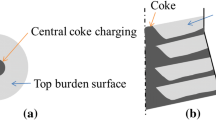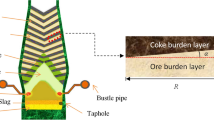Abstract
Reducing coke use is an effective measure to reduce carbon emission and energy consumption in the blast furnace (BF) ironmaking. Essentially, BF is a high-temperature moving bed reactor, where complex physical transformations coupled with complicated reactions occur. This makes it challenging to investigate the factors determining BF performance with the conventional method. A multi-physical field coupling mathematical model of BF was thus developed to describe its mass and heat transfer as well as its intrinsic reactions. Then, the proposed model was validated with the production data. Under coupling conditions, influences of dominating reactions on BF performance (temperature distribution, gas distribution, iron formation reaction, and direct reduction degree) were revealed. The results indicated that coke combustion, indirect reduction, and direct reduction of iron ore mainly took place nearby the shaft tuyere, cohesive zone, and dripping zone, respectively. Besides, the rate of coke solution loss reaction was increased with the rising coke porosity in the cohesive zone. Considering the effect of coke porosity on the efficiency and stability of BF, the coke porosity of 0.42 was regarded as a reasonable value.











Similar content being viewed by others
Abbreviations
- A sl,d :
-
Effective contact area between solid and liquid in unit volume of bed, m2 m−3
- \(b_{\text{H}_{2}}\) :
-
Mole ratio of hydrogen reacted with iron ore to one reacted without iron ore
- \(b_{\text{N}_{2}}\) :
-
Mole ratio of oxygen to nitrogen in tuyere raceway region
- c i :
-
Concentration of species i, mol m−3
- C A :
-
CO concentration
- C p :
-
Heat capacity at constant pressure, J kg−1 K−1
- d l :
-
Liquid droplet diameter, mm
- d l,g :
-
Liquid droplet diameter affected by gas flow, mm
- d l,h :
-
Droplet diameter affected by holdup, mm
- d s :
-
Solid droplet diameter, mm
- d w :
-
Effective packing diameter, mm
- d z :
-
Thickness of domain in out-of-plane direction, m
- D D,i :
-
Diffusion tensor of species i
- D e,i :
-
Effective diffusion coefficient of species i
- D i k :
-
Multicomponent Fick diffusivity of species i, m2 s−1
- D i m :
-
Mixture-averaged diffusion coefficient of species i
- D i T :
-
Thermal diffusion coefficients of species i, kg m−1 s−1
- D k M :
-
Diffusion driving force acting on species k
- E a :
-
Reaction activation energy
- f l :
-
Fraction conversion of liquid
- F g l :
-
Force of gas on liquid
- F g s :
-
Force of gas on solid
- F l g :
-
Force of liquid on gas
- F l,d s :
-
Interaction force of dynamic liquid on solid
- F s g :
-
Force of solid on gas
- g :
-
Gravitational acceleration, m s−2
- G :
-
Gravity, N
- h l,d :
-
Total holdup of dynamic liquid
- h l,t :
-
Total holdup
- I :
-
Identity tensor
- j i :
-
Mass flux diffusive vector of species i, mol m−2 s−1
- k :
-
Thermal conductivity, W m−1 K−1
- k r :
-
Reaction rate constant
- K :
-
Stress tensor, Pa
- M i :
-
Molar mass of species i, kg mol−1
- M n :
-
Mean molar mass, J mol−1 K−1
- p :
-
Pressure, Pa
- P CO :
-
CO partial pressure
- \(P_{\text{CO}_{2}}\) :
-
CO2 partial pressure
- \(P_{\text{H}_{2}\text{O}}\) :
-
H2O partial pressure
- q :
-
Conductive heat flux, W m−2
- q r :
-
Heat flux by radiation, W m−2
- Q :
-
Other heat source, W m−3
- Q m :
-
Mass source, kg m−3 s−1
- Q vd :
-
Viscous dissipation, W m−3
- R :
-
Ideal gas constant, 8.314 J mol−1 K−1
- R d :
-
Degree of iron ore direct reduction
- R i :
-
Reaction rate, mol m−3 s−1
- T :
-
Temperature, K
- u :
-
Velocity, m s−1
- u g :
-
Velocity of gas, m s−1
- u l :
-
Velocity of liquid, m s−1
- u s :
-
Velocity of solid, m s−1
- v :
-
Velocity, m s−1
- v i :
-
Stoichiometric coefficient of species i
- V g :
-
Gas volume, m3
- w c,s :
-
Mass fraction of coke in solid phase
- w i :
-
Mass fraction of species i
- x i :
-
Mole fraction of species i
- X p :
-
Dimensionless pressure drop
- y i :
-
Mole fraction of species i in gas phase
- α p :
-
Coefficient of thermal expansion, K−1
- β :
-
Volume ratio of CO2 to CO
- ε :
-
Porosity
- ε g :
-
Volume fraction of gas
- ε s :
-
Volume fraction of solid
- θ :
-
Contact angle, (°)
- κ :
-
Permeability, m2
- μ g :
-
Viscosity of gas, kg m−1 s−1
- μ l :
-
Viscosity of liquid, kg m−1 s−1
- ρ :
-
Density, kg m−3
- ρ g :
-
Density of gas, kg m−3
- ρ l :
-
Density of liquid, kg m−3
- ρ s :
-
Density of solid, kg m−3
- σ :
-
Surface tension, N m−1
- \({\tau}\) :
-
Viscous stress tensor, Pa
- \({\psi}\) :
-
Shape factor
- \({\psi}\) CO :
-
Mass fraction of CO
- \({\psi}_{\text{CO}_{2}}\) :
-
Mass fraction of CO2
- \({\psi}_{\text{H}_{2}}\) :
-
Mass fraction of H2
- \(\frac{{\Delta p_{\text{e}} }}{\Delta x}\) :
-
Effective pressure gradient, Pa m−1
- ∂ :
-
Coefficient of coke loss reaction
- g:
-
Gas
- h:
-
Holdup
- i, k :
-
Species
- l:
-
Liquid
- s:
-
Solid
References
B. Rahmatmand, A. Tahmasebi, H. Lomas, T. Honeyands, P. Koshy, K. Hockings, A. Jayasekara, Fuel 336 (2023) 127077.
W. Zhang, Z.L. Xue, J.H. Zhang, W. Wang, C.G. Cheng, Z.S. Zou, J. Iron Steel Res. Int. 24 (2017) 778–786.
K. Li, R. Khanna, J. Zhang, Z. Liu, V. Sahajwalla, T. Yang, D. Kong, Fuel 133 (2014) 194–215.
C.L. Zhang, L. Vladislav, R.S. Xu, G. Sergey, K.X. Jiao, J.L. Zhang, T. Li, T. Aleksei, C. Wang, G.W. Wang, Fuel 311 (2022) 122412.
X.F. She, X.W. An, J.S. Wang, Q.G. Xue, L.T. Kong, J. Iron Steel Res. Int. 24 (2017) 608–616.
K. Li, J. Zhang, Y. Liu, M. Barati, Z. Liu, J. Zhong, B. Su, M. Wei, G. Wang, T. Yang, Metall. Mater. Trans. B 47 (2016) 811–818.
H. Zhang, Chem. Eng. J. 347 (2018) 440–446.
D. E, P. Zhou, S. Guo, J. Zeng, Q. Xu, L. Guo, Q. Hou, A. Yu, Fuel 311 (2022) 122490.
Y.Z. Pan, H.B. Zuo, J.S. Wang, Q.G. Xue, G. Wang, X.F. She, J. Iron Steel Res. Int. 27 (2020) 121–131.
K. Takahashi, A. Yoshino, T. Nouchi, J. Kano, S. Ishihara, T. Ariyama, ISIJ Int. 61 (2021) 1488–1497.
A.A. Agra, A. Nicolodi, B.D. Flores, I.V. Flores, G.L.R. da Silva, A.C.F. Vilela, E. Osório, Fuel 304 (2021) 121374.
K.M. Steel, D.R. Jenkins, R.D. Balucan, M.R. Mahoney, Fuel 296 (2021) 120688.
Q. Wei, K. Pang, J. Wu, C. Liang, J. Anal. Appl. Pyrol. 161 (2022) 105381.
E. Donskoi, A. Poliakov, M.R. Mahoney, O. Scholes, Fuel 208 (2017) 281–295.
W.J. Yang, Z.Y. Zhou, A.B. Yu, D. Pinson, Powder Technol. 279 (2015) 134–145.
Z. Li, S. Kuang, S. Liu, J. Gan, A. Yu, Y. Li, X. Mao, Powder Technol. 353 (2019) 385–397.
S. Park, G.M. Choi, M. Tanahashi, Fuel Process. Technol. 175 (2018) 104–112.
H. Nie, Z. Li, S. Kuang, L. Yan, W. Zhong, A. Yu, X. Mao, H. Xu, Fuel 296 (2021) 120662.
B. Amblard, R. Singh, E. Gbordzoe, L. Raynal, Chem. Eng. Sci. 170 (2017) 731–742.
D. Fu, Y. Chen, Y. Zhao, J. D'Alessio, K.J. Ferron, C.Q. Zhou, Appl. Therm. Eng. 66 (2014) 298–308.
J.W. Patrick, A.E. Stacey, Fuel 54 (1975) 213–217.
L. Farcot, N. Le Pierrès, B. Michel, J.F. Fourmigué, P. Papillon, J. Energy Storage 20 (2018) 109–119.
X.F. Dong, A.B. Yu, S.J. Chew, P. Zulli, Metall. Mater. Trans. B 41 (2010) 330–349.
T.J. Park, S.K. Min, H. Kim, D.J. Min, Steel Res. Int. 92 (2021) 2000315.
R. Sakurovs, L. Burke, Fuel Process. Technol. 92 (2011) 1220–1224.
X. Yu, Y. Shen, Metall. Mater. Trans. B 49 (2018) 2370–2388.
M.A. Pavlov, Coal chemistry, Metallurgical Industry Press, Beijing, China, 1957.
B.D. Pandey, U.S. Yadav, Ironmak. Steelmak. 26 (1999) 187–192.
Z. Zhang, J. Meng, L. Guo, Z. Guo, Metall. Mater. Trans. B 47 (2016) 467–484.
X. Yu, Y. Shen, Chem. Eng. Sci. 199 (2019) 50–63.
Acknowledgements
This work was supported by the National Natural Science Foundation of China (Grant Nos. 22278001 and 21776002), the Natural Science Foundation of Anhui Provincial Education Department (No. KJ2021A0407), the Natural Science Foundation of Anhui Province (Grant No. 2008085QB87), and Anhui Provincial Postdoctoral Science Foundation (No. 2021B538).
Author information
Authors and Affiliations
Corresponding authors
Ethics declarations
Conflict of interest
The authors declare that they have no conflict of interest.
Rights and permissions
Springer Nature or its licensor (e.g. a society or other partner) holds exclusive rights to this article under a publishing agreement with the author(s) or other rightsholder(s); author self-archiving of the accepted manuscript version of this article is solely governed by the terms of such publishing agreement and applicable law.
About this article
Cite this article
Chen, J., Lei, Z., Yao, Z. et al. Investigating effect of coke porosity on blast furnace performance based on multi-physical fields. J. Iron Steel Res. Int. 31, 357–367 (2024). https://doi.org/10.1007/s42243-023-01045-w
Received:
Revised:
Accepted:
Published:
Issue Date:
DOI: https://doi.org/10.1007/s42243-023-01045-w




